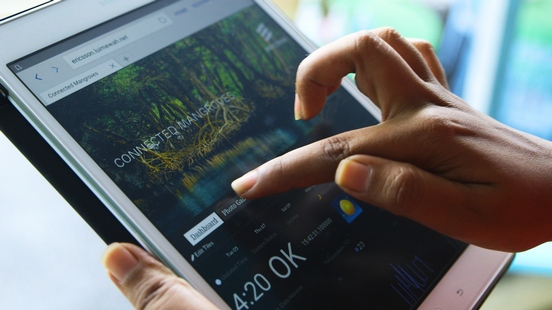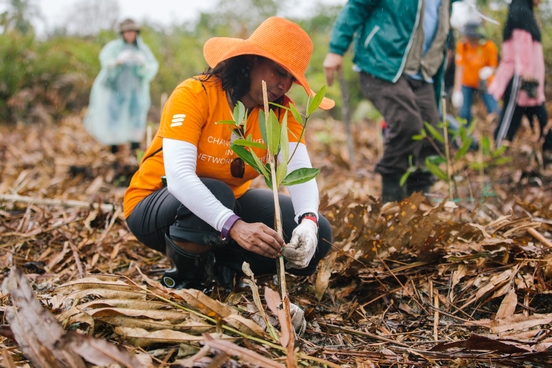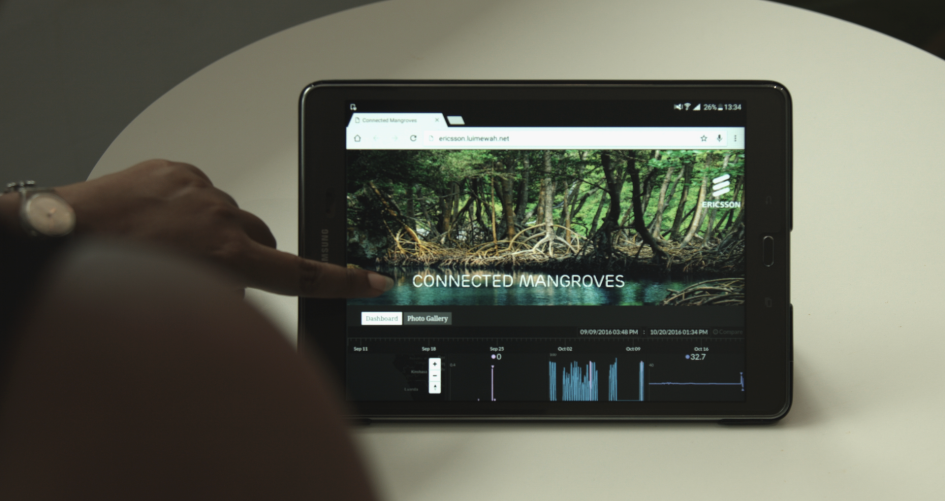Mangroves are a vital part of Malaysia’s ecosystem, protecting villages near coastlines and riverbanks from environmental risks, especially the risks from flooding and tsunamis. Unfortunately, due to illegal logging, fire, soil pollution and sea farming, 50% of mangrove cover has been lost in the last 10 years.
Ericsson’s Connected Mangroves project, the first of its kind in the world, combines
cloud, machine-to-machine and mobile broadband to help the local community in Selangor, Malaysia, to better manage the growth of new mangrove saplings.
Volunteers planted mangrove saplings that have been equipped with sensors that can monitor real-time information about soil and weather conditions, fires, water levels and any intrusion from third parties to ensure positive growth and rehabilitation of eroded coastlines. Data is compiled and sent directly to a cloud system where users, such as farmers, NGOs, analysts and authorities, can have access to it to understand more about the current status of the saplings.
The Connected Mangroves project is an example of how ICT and mobility can be used together to restore dwindling mangrove plantations and thus help absorb carbon emissions while protecting residents from natural disasters such as flooding.
Key facts
- Phase 1 of the project involved a pilot of 200 seedlings and Phase 2 will have 1,000 seedlings. The team's ambition is to plant a total of 10,000 seedlings.
- Based on the initial pilot results, Ericsson expects an improvement rate of up to 50% on the mortality rate of seedlings.
- According to researchers from Duke University, 35,594 acres of mangrove habitats can prevent the release into the atmosphere of about 13 million metric tonnes of carbon, which is equivalent to the carbon emissions of 344,000 cars.
The problem
Based on current NGO estimates, only around 40% of mangrove seedlings in Malaysia are able to reach maturity. The main reasons are lack of water, pollution, fire, illegal logging, and animal intrusion.
The effects of climate change have a large impact on agriculture and on the lives of local communities. Malaysia has seen longer dry seasons followed by rainy seasons that were characterized by widespread flooding. This, together with the deforestation of large areas of mangrove forests has created river bank erosions and lack of natural protection for natural disasters like flooding or tsunamis for local villages. The reforestation of mangrove forests tends to be difficult due to the high mortality rate of the seedlings, especially in areas with pollution or affected by climate change.

The solution
In Ericsson’s Connected Mangroves project, volunteer employees from Ericsson Malaysia, together with members of the local community and regional NGOs, planted mangrove saplings in October 2015. Ericsson worked with Lumeiwah, a local technology company, to place sensors on the newly-planted mangrove saplings. The sensor system provides near real-time information about the mangrove plantation conditions.
Each sensor system can measure these conditions for a maximum of 200 mangroves in the plantation (covering roughly 2,500mts2). The information is sent real-time to a cloud system. From this cloud, users are able to access, almost in real time, information via a web-based dashboard that can be customized for the project's different stakeholders.
The main dashboard metrics defined to measure the health of the mangrove plantations are: soil moisture, temperature, and electric conductivity; ambient humidity, temperature, and water level measurement. For each of these metrics, Ericsson defined thresholds that when surpassed triggers a message to the specified caretaker in the application.
Through improving the quality and quantity of the data, the system is better able to cope with changing parameters. This is relevant when understanding trends about soil temperature, water level or soil acidity and could help researchers to better understand mechanisms to improve the life of seedlings via irrigation, fertilization or other methods.
Helping the planet
Mangroves are among the richest Co2 trees in the world. A typical mangrove hectare consists of 10,000 seedlings. 3.5 hectares of mangroves are capable of absorbing the carbon emissions of one typical passenger automobile per year. Increasing the yield of these hectares could help to increase carbon sequestration per hectare up to 75%.
The project ensures up to 50% better maturity rates for the mangrove saplings, which in itself assures that the community will increase its mangrove cover substantially in the next few years.
Assuming that the mature mangrove trees remain healthy in the coming years, this in itself will transform the shoreline of the community and help protect residents against natural disasters. It will also transform the ecosystem of the river by improving the river's ability to sustain life and assure biodiversity.

Helping people
The communities that live near the mangrove plantation live in basic conditions and don’t have access to advanced technology. They are among the most vulnerable socio-economic groups in the country. Access to this mobile application helps them to manage their mangrove plantations and is considered to be a big step forward in agriculture. In addition, these communities did not previously have resources to monitor the mangrove forest, and so were at risk of flooding. This risk has now been mitigated by the project.
Being able to monitor large areas of forest to prevent fire, flooding and illegal logging can help local authorities to maintain protected forest areas in a better way. Leveraging on ICT technology can help them to find more sustainable and efficient ways to monitor and take actions regarding forest protection.
Universities can access the sensors' data to study the impact of climate change in mangroves and from this data, draw up potential actions to improve the productivity of seedling plantations. NGOs that are driving reforestation programs can leverage on ICT to improve their programs, give more transparency, improve results and support the community in a better way.
Spillover effect
Current technology used by Ericsson is widely available and standardized. Current sensors are widely available in the market and their price range is low, which helps to replicate this activity and scale it. Ericsson is using 3GPP technology for communications (2G/3G) which already has more than 6 billion subscriptions worldwide. This will ensure high level of coverage globally and will also help to find low-cost communication units for the sensor gateway.
Ericsson is also working with local technology providers and communities so that the development of the sensors and the installation and support becomes sustainable. For instance in this case, the basic maintenance is supported by the community chief. The same real-time monitoring could be applied to other agriculture crops or even specific areas like fisheries without major changes.




Images owned by the activity partners, all rights reserved.

